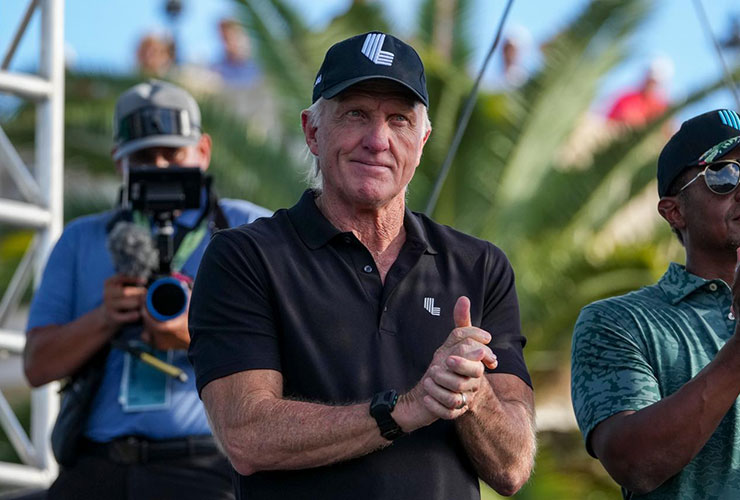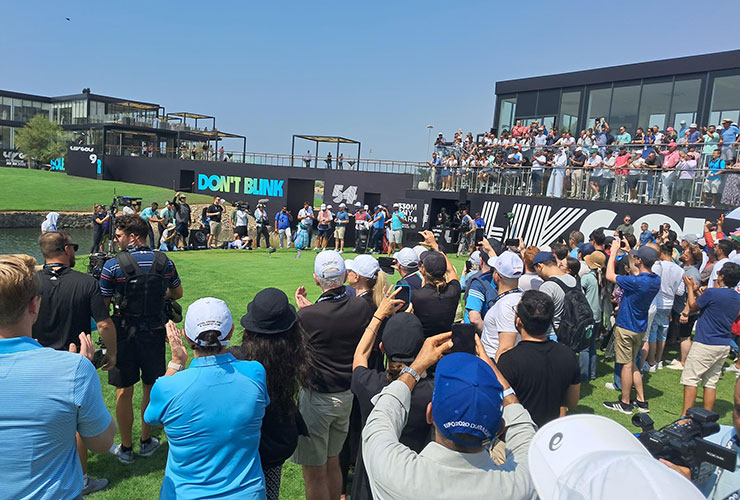LIV Golf hails it as a victory. LIV detractors view it as defeat. Those polar responses should not surprise. The past year of divisions in professional golf has proven reality varies depending on the beholder. To an extent that sentiment applies to LIV’s recent announcement of a multi-year media agreement with The CW network, a deal which brings the circuit to a traditional television platform in the United States.
Yet the true consequence of this LIV development doesn’t hinge on one’s opinion, but more of the question it is trying to answer.
“There’s a lot of different ways to look at it,” says Patrick Rishe, the founding director of the sports business programme at Washington University, “and I guess it depends on one’s perspective as it relates to anything that has to do with LIV versus the PGA Tour. The broader issue is: ‘What is the ultimate goal here?’”
•••
During its inaugural season, LIV Golf was available on broadcast and cable television in more than 150 territories across the world, a nod to the league’s ambition to be an international entity. However, in the United States — where the majority of its tournaments were held and boasting the largest golf consumer audience — LIV could only be seen on YouTube, Facebook or LIV Golf’s website. Though media consumption is dramatically evolving with more platforms and choices than ever before, a streaming-only deal hampered LIV Golf’s reach. Most sports, and especially golf, are still watched in traditional, linear fashion. It’s one of the reasons sports rights are so expensive: They are one of the few programmes watched as scheduled.
Fox Corporation were reportedly in negotiations with LIVGolf in the autumn of last year, but apparently talks broke down over rights fees, as LIV Golf viewed a media deal as a revenue generator while Fox Sports insisted on being paid for showing the product similar to an ad-buy.
Then The CW emerged. Acquired by the Nexstar Media Group in 2022, The CW touts more than 200 affiliates in the United States with a reach of 120 million viewers. The network is primarily known for airing syndicated programming; however, sources told Golf Digest, CW is aiming to break into the sports media space. There’s little direct financial cost associated with The CW’s venture: LIV Golf will not be receiving media rights fees for its deal. Instead the agreement will be an advertisement share between the network and league. If that arrangement sounds unique, it is. For context, the PGA Tour reportedly receives in the neighbourhood of $700 million per year from its media rights partners NBC, CBS and ESPN.
Will Staeger, chief media officer for LIV Golf, asserted the importance of The CW’s availability as what drew the league to the network.
“It’s important for LIV to bring its product and innovative coverage to as many viewers as we can,” Staeger said. “As a start-up league, broad viewership is a linchpin. With The CW we will have a committed partner that will help us reach that goal.”
Staeger said there were multiple bidders for LIV’s rights, and that CW’s pitch best aligned with LIV’s goals. “We believed in our vision, it was about getting that product in front of fans, to engage with more traditional media platforms as well as streamers. We solicited offers, we had multiple networks submit offers and CW emerged victorious.”
The deal is not without its drawbacks for LIV. The league will no longer be streamed for free on Facebook or YouTube, and its Friday rounds will only be shown on CW’s app, which has limited use. Staeger does say that, over the long term, LIV is looking to find a live linear window during its first rounds. “Whether that comes later this year or in other seasons, we’ll develop more unique ways in how it’s presented,” he says.

LIV will also be handling the production coverage, which, while adding to the associated cost of the operation, gives the league control over its presentation. Unlike last year, when the golf was aired without commercial interruption, there will be ads in 2023. Staeger says they will mostly come before and after rounds, with a few mixed in around LIV’s ‘half-time’ of its shotgun start format.
LIV’s on-air commentating team will carry over from the end of 2022 with Arlo White doing play-by-play alongside analysts David Feherty and Jerry Foltz. Dom Boulet, Su-Ann Heng and Troy Mullins will provide on-course coverage. Staeger said the team’s chemistry is “palpable,” and points to TNT’s popular NBA crew as a barometer for LIV’s ambitions.
“We love our announce team. It’s the most diverse team in golf,” Staeger said. “We’re trying to foster something special with our team. We have a jump start because we handle our own production. We have the opportunity, we have a chance to reinvent how the sport is watched.”
•••
According to Nielsen’s metrics, The CW was the 25th most-watched network in the United States in 2022. That is a far cry from the PGA Tour’s broadcast partners, NBC and CBS, which rank first and second, respectively. Because it’s not a network with sports-centric shoulder programming like ESPN or Fox Sports, it’s unlikely LIV Golf will receive audience bumps from CW’s line-up of shows. For the PGA Tour, the outcome, sources say, is considered a sigh of relief.
In that same breath, the deal should not be discounted. Ranking 25th seems low, but not against the fact there are hundreds of channels available to the American consumer. CW’s rank also far outweighs the Golf Channel, which came in 94th.
“It may not be splashy, but that’s something,” Rishe says. “From where they were at, something is better than nothing and it creates an opportunity for other networks to kind of see how this all plays out.”
Despite the constraints of streaming, taking LIV rounds off of YouTube does not appear to be in line with LIV’s stated intention of drawing in a younger audience. Conversely, given LIV Golf’s YouTube numbers last summer — averaging a little under 80,000 views for most of its three-day events — the move to CW, while theoretically limiting who can see it, now gives LIV a guaranteed audience, Rishe says.
“If this were something that younger people were eating up, then you would want to keep it on a place where people are likely to watch like YouTube, where younger people are going, right?” Rishe notes. “But that’s not necessarily the case. We know that golf does trend with an older demographic and therefore I’m sure they were looking for a different dance partner.”
Since its inception, LIV has stated its focus is on a younger crowd. The problem is the type of companies that are involved in the golf business tend to target the older, affluent audience. Even with bringing in new sponsors that haven’t been in the space before, LIV Golf will need to tap into those existing advertisers. CW gives LIV that chance. Though its programming is filled with teen dramas, its average viewer age is still 58 years old, according to Nexstar. Additionally, Rishe said one of the biggest wins for LIV in the deal is the opportunity to prove itself to other potential networks for future deals.
“For LIV, they can see if they can grow this relationship over the next two or three years, or they’re going to use that two or three year window to hopefully prove to another network: ‘Hey, look at this. We’ve gained traction, we’ve gained support,’” Rishe said.
Support and traction are imperative for LIV’s ultimate goal. Officials have touted the franchise component of the endeavour as a primary facilitator for future sponsorships and revenue. Twelve teams are expected to compete in a 14-event schedule beginning in late February. The 12 captains — who figure to be high-profile players such as Phil Mickelson, Bryson DeChambeau, Dustin Johnson, Sergio Garcia and Cameron Smith — would have as much as a 25-per cent equity stake in their teams. Each team would cover their own operating costs, using sponsorships, team prize money and merchandise to do so. To players and potential sponsors and owners, the number LIV Golf has forecasted has stayed consistent, sources tell Golf Digest: a $1 billion potential valuation for a four-man club.
“Sponsor value for any team or league is driven by eyeballs, because one main purpose of any sponsor deal is generating awareness and exposure for your product. If you can’t see it, you can’t sell it,” Rishe said. “[It’s] incredibly hard to achieve awareness and exposure without a solid TV or streaming deal.”
With The CW, those franchises, those sponsorships can now be seen. The revenue streams can be opened. Still, hurdles remain.
•••
After being spurned by almost every major media entity in the US, LIV now has a partner. The symmetry can be drawn to LIV Golf’s launch, when players were initially hesitant to jump, only to follow the lead of Johnson, Mickelson and others. The outcry has lessened with each player’s switch.
It may not be the media deal hyped or promised. Nevertheless, it happened when its critics said it wouldn’t. In golf’s civil war, that alone counts as victory.









